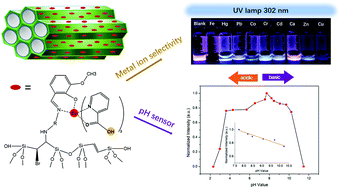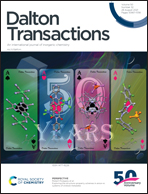Chemical sensors based on a Eu(iii)-centered periodic mesoporous organosilica hybrid material using picolinic acid as an efficient secondary ligand†
Abstract
Through a series of post synthetic modification methods applied to the 100% trans ethenylene-bridged Periodic Mesoporous Organosilica (ePMO), the lanthanide-functionalized hybrid nanomaterial ePMO@Eu_PA (PA = picolinic acid) has been prepared. The pristine and lanthanide-grafted ePMO materials were characterized by powder X-ray diffraction, DRIFTs, TGA, N2 sorption, SEM and TEM. The selected PA ligand could effectively sensitize the Eu3+ ion, leading to the characteristic luminescence of Eu3+ in ePMO@Eu_PA. The luminescence properties of the ePMO@Eu_PA were studied in detail in the solid state and after dispersing in water. The material was investigated for the use as ion sensor and showed a selective monitoring of Fe3+, Co2+ and Cu2+ ions with luminescence quenching. In addition, the material showed a linear relationship between the luminescence intensity and the pH value in the pH range from 7.7 to 10.2. These findings demonstrate that ePMO@Eu_PA possesses potential practical applications in ion sensing as well as in pH sensing.



 Please wait while we load your content...
Please wait while we load your content...